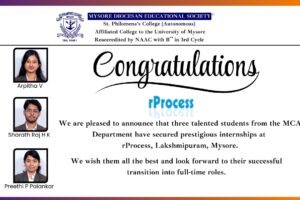Report on Experiential Learning Kandal Cross Shrine Ooty, Tamil Nadu.
Every subject requires a field-based exposure to understand the reality beyond the walls of our classroom. Keeping this in mind, the teaching staffs and group of 20 students from our department organized a study tour to Nilgiri hills in Ooty, Tamil Nadu on 31st July 2022. The main purpose of our visit was to study the Kandal Cross Shrine. We had prior contacted Diocese of Ooty for the details and got the reference of Fr Lourd Pragasam. Also, visited Toda’s village to understand the religious practice of Toda tribe.
Learning outcome: we had very successful study tour to the most important place in India. Our student expressed their great joy to visit this place where they not only had an experienced learning but also could meet their spiritual thirst. They also learnt the culture tradition and rich heritage of the place where they came to know about the various skills which made Ooty rich in its own effort and has a worldwide recognition especially Kandal Cross Shrine and Toda tribe religious practices.

Nilgiri hills
The Nilgiri district is one of the smallest districts in Tamil Nadu. Etymologically, the word ‘Nilgiri’ means Blue Mountains. The district is a hilly area of 2549 sq km located at the junction of the Eastern and the Western Ghats, the two prominent mountain ranges of India. In Nilgiris we can find Tribes like Toda, Kota, Kurumba, Irula, Paniya and Kattunayakan.
Kandal Cross Shrine: An Introduction
Kandal Cross Church is located about 9,080 feet above sea level in Ooty. Some think this church as the Jerusalem of the East. The church has a little-known memorial that is connected with the crucifixion of Jesus Christ. Inside a life-sized bronze, crucifix contains a small sized relic that is encapsulated in a glass case. The relic inside the glass is a tiny dark coloured wood from the original Cross that Christ carried upon which he was finally crucified. Even many who come to this church are said to be unaware of this fact with the exception of few who pray in front of this memorial.

Kandal Cross Shrine also known as the Calvary of South India was found in 1933 by French priest Paul Crayssac. Paul brought the wooden memorial to the shrine on May 1st, 1939 from a museum in Rome where parts of the Holy Cross collected from Jerusalem are preserved.
We began our journey at 6am as we participated the Eucharistic celebration at St. Josephs Cathedral, with the prayer for the safe and fruitful tour. Firstly, we visited Toda Village to understand the religious practices of the Toda tribe.

Next day morning we started our journey after attending the Eucharistic celebration at St Joseph’s Church, Coonoor breakfast was provided in the Salesian Sisters (Don Bosco Retreat center) and we stared at 9 AM. It has breath taking gothic architecture and has ornate interiors. Its magnificent structures’. It was a walking pilgrimage as the vehicles could not
climb the hill. This has an elaborate defense system and heavily armed and fortified during the Portuguese rule. We spent nearly an hour in this place and then proceeded to Ooty Kandal Cross

Kandal Cross Shrine is special for Christians in and around Ooty because the relic of the same cross which Jesus
carried 2000 years ago has been brought here and preserved. On every feast there is special prayers and veneration of the relic of the Cross.

The Shrine has a well which is believed to be the healing water by the people and another
interesting news is even if the nearby water source dries the well never goes off dry. It is preserved by the local church authorities by cleaning every month first saruday.

The Todas: An Introduction
The Todas are found only in the Nilgiri district and traditionally live in settlements consisting of three to seven small, thatched houses, constructed in the shape of half-barrels and spread across the slopes of the pasture of an oval, pent-shaped called as Munds. Their huts symbolize rainbow shape with small doors supposedly to stop stray animals from entering them. Each Munds is not very far from the other and the location of each village is usually beside grassland for grazing buffaloes. There are many Toda villages like Teshteri, Patdu, Kakood, Oomgash, Pabalgore, Tarkosh. Osamanday. Among these villages we can find different clans being residing, and are been divide into 15 clans into endogamous and exogamous. Regarding their place of origin, the

Todas insist that goddess Teikirshy and her brother on first created the buffalo by waving a magic wand, and then created the Toda man. The first Toda woman was created from the right rib of the man and they were its oldest inhabitants in the Nilgiris. They speak Toda language of Dravidian origin but has no script and these people are well versed in Tamil and Kannada also. In 2000, there were 56 occupied Toda munds, 19 households per mund with a population around 1500.

Temple of Todas
That day will be like a fair all the Todas settlement throughout Nilgiris come here to celebrate this day and it will be like a get together. The priest explained about the taboos they have that must be strictly followed in the community. Later some of the Toda women came dressed up in
their traditional attire sang and danced for the Todas songs which is the highlight of their culture. They also explained the meaning of the songs which expresses about the beauty of the nature and their role in protecting it.
The students also joined and danced with the Todas and that was a wonderful moment to all of us. Later the students along with the teachers interacted with the Toda women highlighting about their livelihood options and other aspects of their life. Regarding Marriage and family the members shared that Todas once practiced fraternal polyandry, a practice in which a woman marries all the brothers of a family; this was due to the lack of female population. But in recent years monogamy is been encouraged and practiced. The suitor has to prove his worth to the girl’s family by lifting a heavy stone to his shoulders. The marriage ceremony itself is a celebrated event among all Todas. The members of the clan assemble at a customary place, mostly a tree. A group of settlements of clans might regard a single tree as their place of marriage. The particular tree has a hole which is made to accommodate the lamp, which has a very important role in rituals. During the marriage husband has to present a buffalo and one rupee coin as token of respect. When the girl is pregnant, we come across the ‘bow and arrow’ ceremony in which the girl is presented with the bow and the arrow. This particular rite may suggest an aspiration for a brave boy. This ceremony confirms the clan of the baby. Many of the Toda ceremonies involve an odd number of men. The purification chants are recited 7 times, while other chants are recited 3 times. The members also showed the album of their marriage and sacred bow and arrow ceremony.
Todas have their own traditional dress. It consists of a single piece of cloth, which is worn like the plaid of a Scottish highlander over a dhoti for men and skirt for women. They wrap themselves with an embroidery shawl with different colors. Each color has significance like
cream color indicates Infant, red for adolescence and black for maturity. Women have very unique hairstyles with elegant jewels. The Todas are vegetarians. Buffalo milk is made into butter, butter milk, yogurt, and cheese drunk plain. Rice is mainly eaten and is eaten with dairy products and curries.
Overall, the visit was very fruitful, the students were able to understand the Todas beliefs, practices and the changes and trends among them. The team received a very good hospitality, and it was very interactive throughout the visit.



